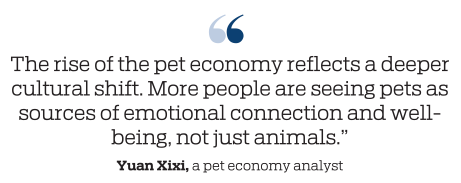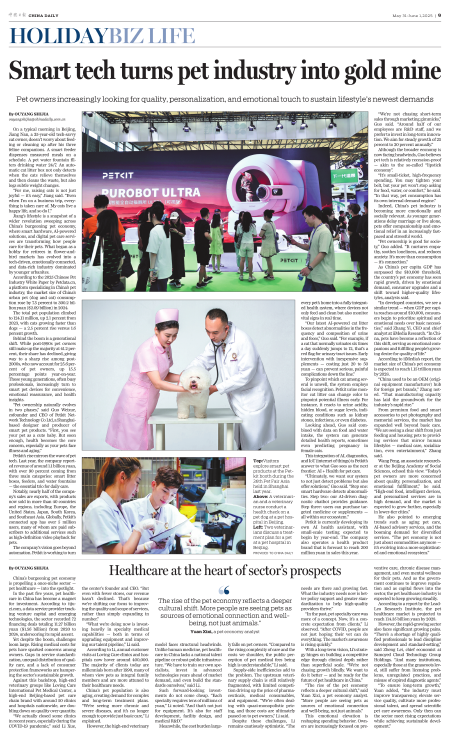
China's burgeoning pet economy is propelling a once-niche sector — pet healthcare — into the spotlight.
In the past five years, pet healthcare in China has become a magnet for investment. According to itjuzi.com, a data service provider tracking venture capital and emerging technologies, the sector recorded 72 financing deals totaling 11.27 billion yuan ($1.56 billion) from 2020 to 2024, underscoring its rapid ascent.
Yet despite the boom, challenges loom large. Rising medical costs for pets have sparked concerns among owners. Gaps in service standardization, unequal distribution of quality care, and a lack of consumer protection frameworks are hampering the sector's sustainable growth.
Against this backdrop, high-end veterinary groups like Loving Care International Pet Medical Center, a high-end Beijing-based pet care chain brand with around 50 clinics and hospitals nationwide, are doubling down on quality over quantity.
"We actually closed some clinics in recent years, especially during the COVID-19 pandemic," said Li Xue, the center's founder and CEO. "But even with fewer stores, our revenue hasn't declined. That's because we're shifting our focus to improving the quality and scope of services, rather than simply expanding in number."
"What we're doing now is investing heavily in specialty medical capabilities — both in terms of upgrading equipment and improving our talent pipeline," Li said.
According to Li, annual customer visits at Loving Care clinics and hospitals now hover around 400,000. The majority of clients today are millennials born after 1990, many of whom view pets as integral family members and are more attuned to their healthcare needs.
China's pet population is also aging, creating demand for complex and long-term treatment plans. "We're seeing more chronic and severe diseases, and it's no longer enough to provide just basic care," Li explained.
However, the high-end veterinary model faces structural headwinds. Unlike human medicine, pet healthcare in China lacks a national talent pipeline or robust public infrastructure. "We have to train our own specialists, invest in advanced technologies years ahead of market demand, and even build the standards ourselves," said Li.
Such forward-looking investments do not come cheap. "Each specialty requires tens of millions of yuan," Li noted. "And that's not just for equipment. It's also for staff development, facility design, and medical R&D."
Meanwhile, the cost burden largely falls on pet owners. "Compared to the rising complexity of care and the costs we shoulder, the public perception of pet medical fees being high is understandable," Li said.
Supply-side inefficiencies add to the problem. The upstream veterinary supply chain is still relatively fragmented, with limited competition driving up the price of pharmaceuticals, medical consumables, and equipment. "We're often dealing with quasi-monopolistic pricing, and those costs are ultimately passed on to pet owners," Li said.
Despite these challenges, Li remains cautiously optimistic. "The needs are there and growing fast. What the industry needs now is better policy support and greater standardization to help high-quality providers thrive."
"In the past, pet specialty care was more of a concept. Now, it's a concrete expectation from clients," Li observed. "After COVID, people are not just hoping their vet can do everything. The market's awareness is rising quickly."
With a long-term vision, Li's strategy hinges on building a competitive edge through clinical depth rather than superficial scale. "We're not chasing growth blindly. We want to do it better — and be ready for the future of pet healthcare in China."
"The rise of the pet economy reflects a deeper cultural shift," said Yuan Xixi, a pet economy analyst. "More people are seeing pets as sources of emotional connection and well-being, not just animals."
This emotional elevation is reshaping spending behavior. Owners are increasingly focused on preventive care, chronic disease management, and even mental wellness for their pets. And as the government continues to improve regulation and as capital flows into the sector, the pet healthcare industry is expected to keep growing steadily.
According to a report by the Lead-Leo Research Institute, the pet healthcare market is projected to reach 114.35 billion yuan by 2028.
However, the rapid-growing sector also faces significant growing pains. "There's a shortage of highly qualified professionals to lead discipline development and standard-setting," said Zheng Lei, chief economist at Samoyed Cloud Technology Group Holdings. "And many institutions, especially those at the grassroots level, still suffer from licensing problems, unregulated practices, and misuse of expired diagnostic agents."
"To ensure long-term growth," Yuan added, "the industry must improve transparency, elevate service quality, cultivate more professional talent, and spread scientific pet care awareness. Only then can the sector meet rising expectations while achieving sustainable development."

